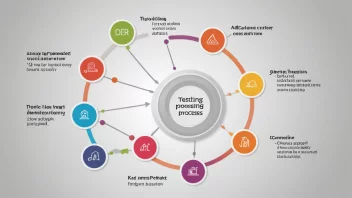Introduction
In this article, you will learn about cryptographic hashing algorithms, their role in blockchain technology, and their applications in ensuring data integrity and secure password storage. By the end of this guide, you will have a comprehensive understanding of how these algorithms operate and their significance in various domains.
Step 1: What is a Cryptographic Hashing Algorithm?
A cryptographic hashing algorithm is a mathematical function that converts an input (or 'message') into a fixed-size string of bytes. The output, typically called the hash value or hash code, is unique to each unique input. Here are some key characteristics:
- Deterministic: The same input will always produce the same output.
- Fast Computation: Hashes can be computed quickly for any given data.
- Pre-image Resistance: It should be infeasible to generate the original input from its hash output.
- Collision Resistance: It should be difficult to find two different inputs that produce the same hash output.
- Small Changes Produce Large Differences: A minor change in input should produce a drastically different hash.
Step 2: Applications in Blockchain Technology
Blockchain technology relies heavily on hashing algorithms for various functionalities:
- Block Integrity: Each block in a blockchain contains the hash of the previous block, linking them together securely.
- Transaction Verification: Hashes are used to verify that transactions have not been altered.
- Consensus Mechanisms: Many consensus protocols employ hashing to validate transactions and blocks.
Step 3: Common Cryptographic Hashing Algorithms
Some of the most widely used cryptographic hashing algorithms include:
- SHA-256: A part of the SHA-2 family, commonly used in Bitcoin and other cryptocurrencies.
- SHA-3: The latest member of the Secure Hash Algorithm family, known for its flexibility and security.
- RIPEMD-160: Often used in Bitcoin addresses, it provides a unique hash for secure identification.
- Whirlpool: Designed for high security and efficiency, commonly used in file integrity verification.
Step 4: Implementing a Hashing Algorithm
Below is a simple implementation of SHA-256 hashing using Python:
import hashlib
def hash_data(data):
sha256_hash = hashlib.sha256()
sha256_hash.update(data.encode())
return sha256_hash.hexdigest()
# Example usage
input_data = "Hello, Blockchain!"
hashed_output = hash_data(input_data)
print(f"The SHA-256 hash of '{input_data}' is: {hashed_output}")Step 5: Ensuring Data Integrity
To ensure data integrity using hashing algorithms, follow these steps:
- Hash Original Data: Compute the hash of the original data and store it securely.
- Rehash Data: Whenever the data is accessed or modified, compute the hash again.
- Compare Hashes: If the newly computed hash matches the stored hash, the data has not been altered.
Step 6: Password Storage Best Practices
When storing passwords, it's critical to use hashing algorithms correctly:
- Use Salt: Add a unique salt to each password before hashing to prevent rainbow table attacks.
- Choose a Strong Algorithm: Use a secure algorithm like bcrypt, Argon2, or PBKDF2 that is designed for password hashing.
- Hash Multiple Times: Perform multiple iterations of hashing to slow down brute-force attacks.
Step 7: Case Study - Bitcoin
Bitcoin’s implementation of SHA-256 showcases the utility of cryptographic hashing in a real-world application:
Each Bitcoin transaction is hashed, and transactions are grouped into blocks. Each new block contains the hash of the previous block, creating a secure chain that is tamper-proof. This ensures that once a transaction is recorded, it cannot be altered without the consensus of the network.
Conclusion
In conclusion, cryptographic hashing algorithms are fundamental to ensuring data integrity, securing passwords, and maintaining the structure of blockchain technology. By understanding how these algorithms work and implementing best practices, individuals and organizations can significantly enhance their data security.
Remember to choose the right hashing algorithm based on your needs, and always keep security as a top priority.






